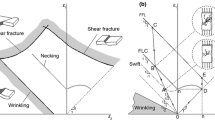Abstract
A criterion for ductile fracture is applied to the formability prediction of an aluminum 2024 alloy sheet and its laminated composite sheets. Axisymmetric deep-drawing processes of the 2024 sheet and the laminates clad by mild steel sheets are simulated by the finite-element method. From the calculated distributions and histories of stress and strain, the fracture initiation site and the forming limit are predicted by means of the ductile fracture criterion. The predictions so obtained are compared with experimental observations. The results show that the fracture initiation in the 2024 sheet with no appearance of necking is successfully predicted by the present numerical approach. Furthermore, it is found that the formability of the 2024 sheet is improved by sandwiching it with the mild steel sheets.
Similar content being viewed by others
References
N. Kawai, T. Mori, M. Inoue, and Y. Liu: Trans. Jpn. Soc. Mech. Eng., 1986, vol. 52C, pp. 1689–95.
S.D. Antolovich, A. Saxena, and G.R. Chanani: Eng. Fract. Mech., 1975, vol. 7, pp. 649–52.
W.J. Mills and R.W. Hertzberg: Eng. Fract. Mech., 1975, vol. 7, pp. 705–11.
T. Takamatsu and M. Ichikawa: JSME Int. J., 1987, vol. 30, pp. 1035–41.
J. Zuidema and M. Mannesse: Eng. Fract. Mech., 1991, vol. 40, pp. 105–17.
O. Partl and J. Schijve: Int. J. Fatigue, 1993, vol. 15, pp. 293–99.
H.W. Swift: J. Mech. Phys. Solids, 1952, vol. 1, pp. 1–18.
R. Hill: J. Mech. Phys. Solids, 1952, vol. 1, pp. 19–30.
Z. Marciniak and K. Kuczynski: Int. J. Mech. Sci., 1967, vol. 9, pp. 609–20.
S. Stören and J.R. Rice: J. Mech. Phys. Solids, 1975, vol. 23, pp. 421–41.
S.E. Clift, P. Hartley, C.E.N. Sturgess, and G.W. Rowe: Int. J. Mech. Sci., 1990, vol. 32, pp. 1–17.
K. Osakada and K. Mori: Ann. CIRP, 1978, vol. 27, pp. 135–39.
S.I. Oh, C.C. Chen, and S. Kobayashi: Trans. ASME, J. Eng. Ind., 1979, vol. 101, pp. 36–44.
M. Ayada, T. Higashino, and K. Mori: Advanced Technology of Plasticity, K. Lange, ed., Springer-Verlag, Berlin, 1987, vol. 1, pp. 553–58.
M. Toda, T. Miki, S. Yanagimoto, and K. Osakada: J. Jpn. Soc. Technol. Plasticity, 1988, vol. 29, pp. 971–76.
M. Oyane, T. Sato, K. Okimoto, and S. Shima: J. Mech. Working Technol., 1980, vol. 4, pp. 65–81.
R. Hill: The Mathematical Theory of Plasticity, Oxford University Press, Oxford, United Kingdom, 1950, pp. 318–21.
K. Osakada, J. Nakano, and K. Kori: Int. J. Mech. Sci., 1982, vol. 24, pp. 459–68.
E. Siebel: Stahl Eisen, 1954, vol. 74, pp. 155–58.
Author information
Authors and Affiliations
Rights and permissions
About this article
Cite this article
Takuda, H., Hatta, N. Numerical analysis of the formability of an aluminum 2024 alloy sheet and its laminates with steel sheets. Metall Mater Trans A 29, 2829–2834 (1998). https://doi.org/10.1007/s11661-998-0323-7
Received:
Issue Date:
DOI: https://doi.org/10.1007/s11661-998-0323-7




